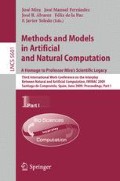Abstract
In this work the concept of computational agent is located within the methodological framework of levels and domains of description of a calculus in the context of different usual paradigms in Artificial Intelligence (symbolic, situated, connectionist, and hybrid). Emphasis in the computable aspects of agent theory is put, leaving open the possibility to the incorporation of other aspects that are still pure cognitive nomenclature without any computational counterpart of equivalent semantic richness. These ideas are currently being implemented on semi-automatic video-surveillance.
Access this chapter
Tax calculation will be finalised at checkout
Purchases are for personal use only
Preview
Unable to display preview. Download preview PDF.
References
Agha, G.: Actors: A Model of Concurrent Computing in Distributed Systems. The MIT Press, Cambridge (1986)
Bertier, M., Marin, O., Sens, P.: Performance analysis of a hierarchical failure detector. In: Proceedings of the International Conference on Dependable Systems and Networks, DSN 2003, pp. 635–644 (2003)
Cuena, J., Demazeau, Y., Garcia-Serrano, A., Treur, J.: Knowledge Engineering and Agent Technology. Frontiers in Artificial Intelligence and Applications, vol. 52. IOS Press, Amsterdam (2003)
Franklin, S., Graesser, A.: Is it an agent, or just a program?: A taxonomy for autonomous agents. In: Jennings, N.R., Wooldridge, M.J., Müller, J.P. (eds.) ECAI-WS 1996 and ATAL 1996. LNCS, vol. 1193, pp. 121–135. Springer, Heidelberg (1997)
Gascueña, J.M., Fernández-Caballero, A.: The INGENIAS methodology for advanced surveillance systems modelling. In: Mira, J., Álvarez, J.R. (eds.) IWINAC 2007. LNCS, vol. 4528, pp. 541–550. Springer, Heidelberg (2007)
Guessoum, Z., Briot, J.P., Marin, O., Hamel, A., Sens, P.: Dynamic and adaptive replication for large-scale reliable multi-agent systems. In: Proceedings of the 1st International Workshop on Software Engineering for Large-Scale Multi-Agent Systems, SELMAS 2002, pp. 26–30 (2002)
Jiang, Y., Xia, Z., Zhong, Y., Zhang, S.: The construction and analysis of agent fault-tolerance model based on pi-calculus. In: Bubak, M., van Albada, G.D., Sloot, P.M.A., Dongarra, J. (eds.) ICCS 2004. LNCS, vol. 3038, pp. 591–598. Springer, Heidelberg (2004)
López, M.T., Fernández-Caballero, A., Fernández, M.A., Mira, J., Delgado, A.E.: Dynamic visual attention model in image sequences. Image and Vision Computing 25(5), 597–613 (2007)
López, M.T., Fernández-Caballero, A., Fernández, M.A., Mira, J., Delgado, A.E.: Visual surveillance by dynamic visual attention method. Pattern Recognition 39(11), 2194–2211 (2006)
Marr, D.: Vision. Freeman, San Francisco (1982)
Martínez, R., Rincón, M., Bachiller, M., Mira, J.: On the correspondence between objects and events for the diagnosis of situations in visual surveillance tasks. Pattern Recognition Letters 29(8), 1117–1135 (2008)
Maturana, H.R.: The organization of the living: A theory of the living organization. International Journal of Man-Machine Studies 7, 313–332 (1975)
McCulloch, W.S.: Embodiments of Mind. The MIT Press, Cambridge (1965)
Mira, J., Delgado, A.E., Moreno-Diaz, R.: Cooperative processes in cerebral dynamic. Applications of Information and Control Systems 3, 273–280 (1979)
Meyer, B.: Object-Oriented Software Construction. Prentice Hall, Englewood Cliffs (1997)
Minsky, M.L.: Steps towards Artificial Intelligence. Proceedings of the Institute of Radio Engineers 49, 8–30 (1961)
Newell, A., Simon, H.A.: Human Problem Solving. Prentice Hall, Englewood Cliffs (1972)
Nunes de Castro, L.: Fundamentals of Natural Computing: Basic Concepts, Algorithms, and Applications. Chapman & Hall/CRC, Boca Raton (2006)
Padgham, L., Zambonelli, F.: AOSE VII / AOSE 2006. LNCS, vol. 4405. Springer, Heidelberg (2007)
Padgham, L., Winikoff, M.: Developing Intelligent Agents Systems: A Practical Guide. John Wiley and Sons, Chichester (2004)
Pavón, J., Gómez-Sanz, J., Fernández-Caballero, A., Valencia-Jiménez, J.J.: Development of intelligent multi-sensor surveillance systems with agents. Robotics and Autonomous Systems 55(12), 892–903 (2007)
Rao, A.S., Georgeff, M.P.: Modeling rational agents within a BDI-architecture. In: Proceedings of the 2nd International Conference on Principles of Knowledge Representation and Reasoning, KR 1991, pp. 473–484 (1991)
Russell, S., Norvig, P.: Artificial Intelligence: A Modern Approach, 2nd edn. Prentice Hall, Englewood Cliffs (2002)
Valencia-Jiménez, J.J., Fernández-Caballero, A.: Holonic multi-agent systems to integrate independent multi-sensor platforms in complex surveillance. In: Proceedings of the IEEE International Conference on Advanced Video and Signal based Surveillance, AVSS 2006, p. 49 (2006)
Varela, F.J.: Principles of Biological Autonomy. North-Holland, Amsterdam (1979)
von Neumann, J.: The Computer and the Brain. Yale University Press, New Haven (1958)
Weiss, G.: Multiagent Systems: A Modern Approach to Distributed Artificial Intelligence. The MIT Press, Cambridge (1999)
Wiener, N.: Cybernetics: Or the Control and Communication in the Animal and the Machine. Wiley, Chichester (1961)
Author information
Authors and Affiliations
Editor information
Editors and Affiliations
Rights and permissions
Copyright information
© 2009 Springer-Verlag Berlin Heidelberg
About this paper
Cite this paper
Mira, J., Delgado, A.E., Fernández-Caballero, A., Gascueña, J.M., López, M.T. (2009). Computational Agents to Model Knowledge - Theory, and Practice in Visual Surveillance. In: Mira, J., Ferrández, J.M., Álvarez, J.R., de la Paz, F., Toledo, F.J. (eds) Methods and Models in Artificial and Natural Computation. A Homage to Professor Mira’s Scientific Legacy. IWINAC 2009. Lecture Notes in Computer Science, vol 5601. Springer, Berlin, Heidelberg. https://doi.org/10.1007/978-3-642-02264-7_39
Download citation
DOI: https://doi.org/10.1007/978-3-642-02264-7_39
Publisher Name: Springer, Berlin, Heidelberg
Print ISBN: 978-3-642-02263-0
Online ISBN: 978-3-642-02264-7
eBook Packages: Computer ScienceComputer Science (R0)

